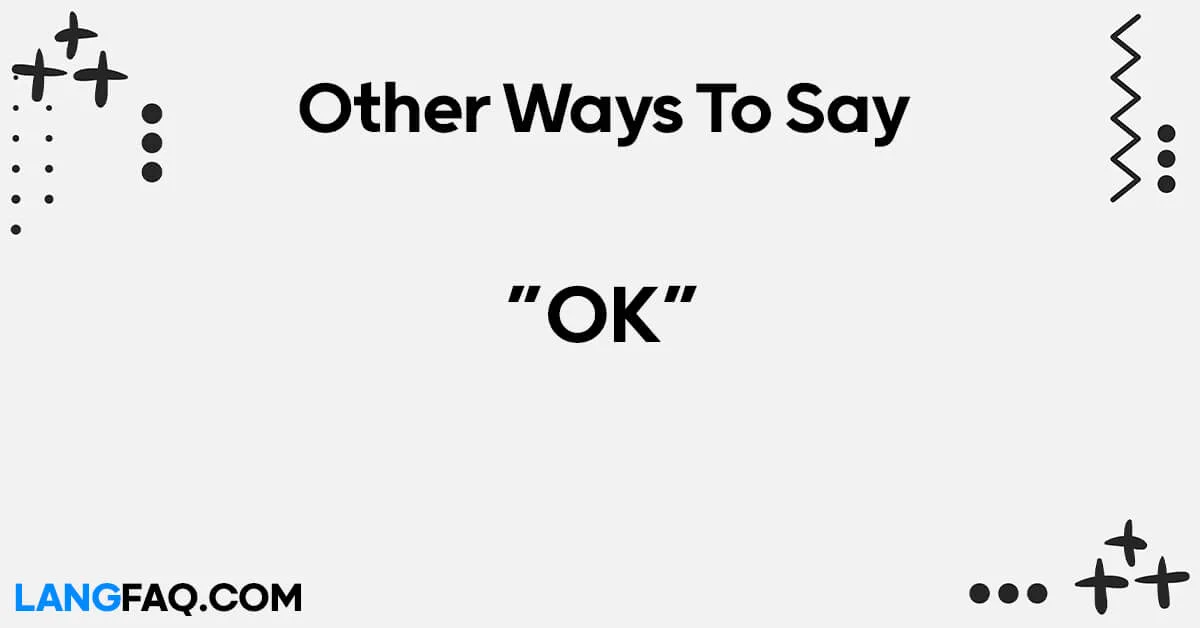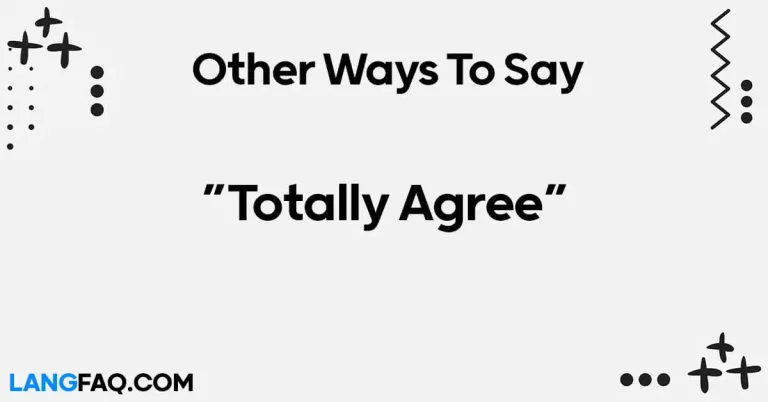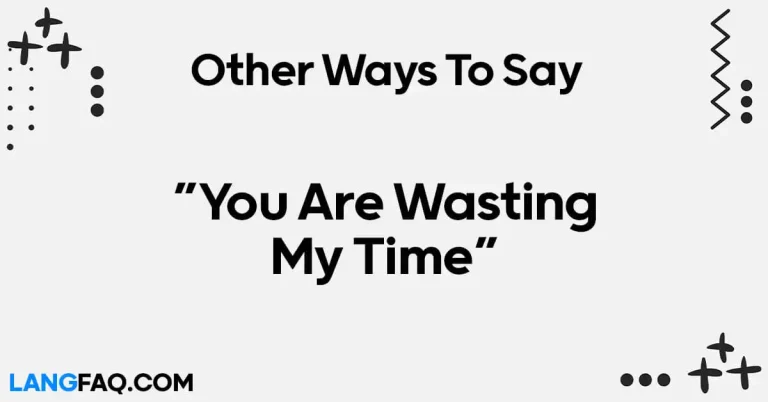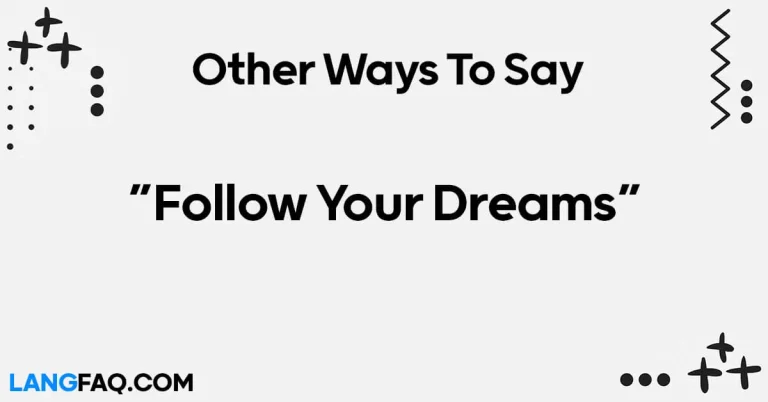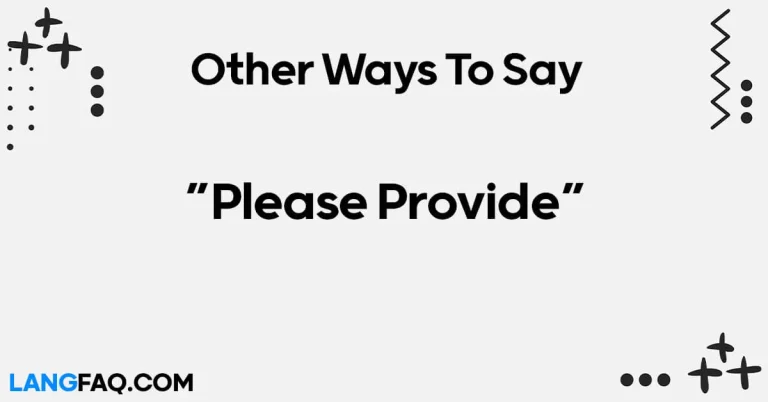In the world of professional communication, the way we express agreement or acknowledgment matters. Saying “OK” repeatedly can make your emails monotonous. This article explores 12 diverse ways to convey agreement, ensuring your emails are not only professional but also engaging.
12 Other Ways to Say OK in an Email
Here they are:
- Acknowledged
- Understood
- Certainly
- Agreed
- Affirmative
- Absolutely
- Got it
- Sure thing
- That works for me
- I concur
- Roger that
- All clear
Here’s a table with the meaning and examples of each alternative for “OK” in an email:
| Expression | Meaning | Examples |
|---|---|---|
| Acknowledged | Formal acknowledgment of received information | “Your message has been acknowledged.” |
| Understood | Conveys comprehension and agreement | “Noted and understood, thank you.” |
| Certainly | Formal affirmation of agreement | “Certainly, I will proceed with the given instructions.” |
| Agreed | Indicates alignment and agreement | “I have reviewed your proposal and agreed to the terms.” |
| Affirmative | Positive confirmation | “An affirmative response to your request.” |
| Absolutely | Strong agreement, expressing certainty | “Absolutely, I support your proposed changes.” |
| Got it | Informal acknowledgment, understanding | “Got it, I’ll make the necessary updates.” |
| Sure thing | Casual agreement, expressing willingness | “Sure thing, I can attend the meeting.” |
| That works for me | Agreement with proposed solution | “Your suggested time for the call works for me.” |
| I concur | Formal agreement, often used in discussions | “I concur with the points raised in the presentation.” |
| Roger that | Acknowledgment often used in military context | “Received and understood, we’ll proceed accordingly.” |
| All clear | Signifying complete understanding | “Instructions received and all clear for implementation.” |
Diversifying your expressions for agreement in emails is essential for effective communication. This table provides a range of alternatives to the commonplace “OK,” allowing you to tailor your responses to the formality of the situation and add a layer of nuance to your professional interactions. Experiment with these alternatives to elevate your email communication and convey your acknowledgment in a more varied and engaging manner.
Is It Correct to Say “OK”?
The term “OK” is undoubtedly one of the most commonly used expressions in everyday language. Its simplicity and brevity make it a go-to choice for quick acknowledgment or agreement. However, the appropriateness of using “OK” depends on the context and the level of formality required in your communication.
Origins of “OK”:
The exact origin of “OK” is subject to some debate, but one popular theory suggests that it originated in the 19th century as an abbreviation of the phrase “oll korrect,” a humorous misspelling of “all correct.” It gained widespread usage during political campaigns and eventually became a part of everyday language.
Pros of Using “OK”:
- Simplicity and Clarity: “OK” is concise and straightforward, making it a clear and unambiguous expression of agreement or acknowledgment.
- Universality: It is recognized and understood globally, transcending language barriers.
- Informality: In casual settings or quick communications, “OK” can be perfectly suitable, maintaining a friendly tone.
Cons of Using “OK”:
- Lack of Nuance: “OK” may lack the nuance required for certain professional or formal situations where a more detailed acknowledgment is appreciated.
- Perceived Informality: In certain contexts, repeated use of “OK” may be perceived as too casual or unprofessional.
- Overuse Concerns: Overreliance on “OK” can lead to monotony in communication and may diminish the impact of your responses.
Grammar Insights:
“OK” is considered an informal expression and is often used in casual spoken and written language. While widely accepted, it may not be the best choice in formal written documents or professional correspondence where a more polished and detailed response is expected.
When to Use “OK”:
- Casual Conversations: In everyday, informal conversations with friends, family, or colleagues, “OK” is perfectly acceptable.
- Quick Confirmations: For quick, uncomplicated confirmations or agreements, “OK” is suitable.
- Text Messaging: In the realm of text messaging and quick email exchanges, “OK” serves its purpose efficiently.
When to Avoid “OK”:
- Professional Correspondence: In formal emails, business proposals, or official documents, consider more formal alternatives to convey acknowledgment.
- Client Communication: When interacting with clients or stakeholders, opting for a more polished expression may be advisable.
- Repeated Usage: Avoid excessive use of “OK” within the same conversation to prevent it from sounding monotonous.
Professional Mail Example With “OK”
Subject: Confirmation of Meeting Schedule
Dear [Recipient’s Name],
I hope this email finds you well. I wanted to confirm the details of our upcoming meeting scheduled for [Date] at [Time] regarding the [Project/Topic].
Could you please acknowledge your availability for the proposed time? Your confirmation is crucial for ensuring that we have all key stakeholders present and can make the most of our discussion.
Your prompt response will be highly appreciated. Feel free to respond with a simple “OK” or, if you have any concerns or would like to suggest an alternative time, kindly let me know at your earliest convenience.
Thank you for your cooperation, and I look forward to our productive meeting.
Best regards,
[Your Full Name] [Your Position] [Your Company] [Contact Information]
Acknowledged: Mastering Formal Acknowledgment
In professional communication, the term “Acknowledged” carries weight, indicating a formal acknowledgment of received information. This phrase is suitable for formal contexts, emphasizing respect and adherence to protocols.
When to Use:
- Formal Correspondence: In business emails or official communications, use “Acknowledged” to convey a professional acknowledgment.
Example Sentence:
“Dear [Sender’s Name],
Your proposal has been acknowledged, and we appreciate the detailed information provided. We will review it thoroughly and get back to you soon.
Best regards, [Your Name]”
Variations:
- Colleague Interaction: In a more casual setting with colleagues, a simple “Got it, thanks!” can be used for a lighter tone.
Understood: Expressing Comprehension and Agreement
“Understood” is a versatile term that conveys both comprehension and agreement. It’s a powerful yet simple way to assure the sender that their message has been received and processed.
When to Use:
- Professional Communication: Employ “Understood” in professional settings to confirm your understanding of the given information.
Example Sentence:
“Hi [Sender’s Name],
Understood, I’ll proceed with the necessary adjustments to meet the deadline. Thank you for the clarification.
Best regards, [Your Name]”
Variations:
- Casual Setting: For a more informal tone among friends or familiar colleagues, use “Got it, I’m on it!”
Certainly: Adding Formality and Assurance
Certainly is a phrase that adds formality and assurance to your responses, making it suitable for business or formal communication.
When to Use:
- Client Interaction: Utilize “Certainly” when responding to clients or in scenarios where a formal tone is crucial.
Example Sentence:
“Dear [Client’s Name],
Certainly, we can incorporate the changes you’ve suggested. Your feedback is invaluable, and we appreciate your input.
Best regards, [Your Name]”
Variations:
- Approachable Tone: In a mentor-mentee context, consider using “Absolutely, I’m here to help!” to maintain a friendly yet supportive tone.
Agreed: Aligning Thoughts Professionally
“Agreed” is a concise yet powerful way to express alignment and agreement, fostering a sense of collaboration in professional exchanges.
When to Use:
- Team Discussions: Employ “Agreed” during team discussions or when reaching a consensus is essential.
Example Sentence:
“Hi [Team],
Agreed, let’s implement the proposed changes in the upcoming project. I believe this aligns well with our objectives.
Best regards, [Your Name]”
Variations:
- Friendlier Approach: In casual conversations with colleagues, switch to “Sounds good, I’m on board!” for a more informal touch.
Affirmative: Providing Positive Confirmation
“Affirmative” is a direct and positive way to confirm information. It’s particularly effective when clarity and directness are required.
When to Use:
- Official Confirmations: Use “Affirmative” in official confirmations or situations that demand a clear and direct response.
Example Sentence:
“Dear [Recipient],
Your request for additional resources is affirmative. We’ll process the necessary arrangements promptly.
Best regards, [Your Name]”
Variations:
- Friendly Affirmation: When communicating with a friendly tone, opt for “Absolutely, we’ll take care of it!” to maintain positivity.
Absolutely: Emphasizing Wholehearted Agreement
“Absolutely” goes beyond a simple agreement; it emphasizes wholehearted support or approval. It’s a versatile term suitable for various professional contexts.
When to Use:
- Key Decisions: Use “Absolutely” when expressing strong agreement, especially in discussions involving key decisions.
Example Sentence:
“Hi [Team],
Absolutely, I support the proposal for restructuring our workflow. It aligns with our long-term goals.
Best regards, [Your Name]”
Variations:
- Casual Agreement: When interacting with colleagues in a more casual setting, switch to “Totally, let’s go for it!” for a relaxed tone.
Got it: Injecting Informality with Clarity
“Got it” strikes a balance between formality and informality. It’s versatile, suitable for various scenarios, and injects a touch of friendliness into your response.
When to Use:
- Routine Instructions: Use “Got it” for routine instructions or when a more informal tone is acceptable.
Example Sentence:
“Hey [Colleague],
Got it, I’ll handle the coordination for the upcoming event. Thanks for letting me know.
Best, [Your Name]”
Variations:
- Acknowledging Thanks: When expressing gratitude, consider “Got it, and thanks a bunch!” for a friendly acknowledgment.
Sure Thing: Balancing Professionalism and Friendliness
“Sure thing” adds a dash of casual flair to your agreement, making it suitable for scenarios where maintaining professionalism with a touch of friendliness is essential.
When to Use:
- Friendly Requests: Use “Sure thing” when responding to friendly requests or when a more relaxed tone is appropriate.
Example Sentence:
“Hi [Friend],
Sure thing, I’d be happy to help with your presentation. Let me know the details.
Cheers, [Your Name]”
Variations:
- Colleague Collaboration: In a work setting, switch to “Absolutely, it’s a sure thing!” to maintain a balance between professionalism and camaraderie.
That Works for Me: Flexibility with a Positive Spin
“That works for me” is an excellent way to express agreement while showcasing flexibility and a positive attitude.
When to Use:
- Negotiations: Use “That works for me” during negotiations or discussions where compromise and agreement are crucial.
Example Sentence:
“Hi [Negotiation Partner],
Your proposed terms work for me. Let’s move forward with the agreed-upon conditions.
Best, [Your Name]”
Variations:
- Friendly Agreement: In a more informal setting, consider “Sounds good to me!” to maintain a friendly and positive vibe.
I Concur: Elevating Language for Formality
“I concur” provides a more sophisticated alternative for expressing agreement, making it suitable for formal or professional settings.
When to Use:
- Official Correspondence: Use “I concur” in official documents, formal emails, or situations where elevated language is required.
Example Sentence:
“Dear [Recipient],
I have reviewed the proposal, and I concur with the suggested approach. Excellent work.
Sincerely, [Your Name]”
Variations:
- Colleague Collaboration: When communicating with colleagues, consider “I agree wholeheartedly” for a more approachable tone without sacrificing formality.
Roger That: Acknowledging in a Direct Manner
“Roger that” is a concise acknowledgment often associated with military communication. It’s direct, indicating that the message has been received and understood.
When to Use:
- Quick Acknowledgment: Use “Roger that” in situations that require a quick and direct acknowledgment, often in fast-paced environments.
Example Sentence:
“Hi [Team],
The changes have been noted—Roger that. We’ll proceed accordingly.
Best, [Your Name]”
Variations:
- Friendlier Tone: In a more casual setting with colleagues, switch to “Got it, loud and clear!” for a friendlier acknowledgment.
All Clear: Signifying Complete Understanding
“All clear” is used to signify not just acknowledgment but complete understanding. It’s often associated with situations where clarity is crucial.
When to Use:
- Instructions Requiring Clarity: Use “All clear” when responding to instructions that demand not just acknowledgment but a confirmation of full comprehension.
Example Sentence:
“Dear [Supervisor],
Instructions received and all clear for the upcoming project. I’ll commence the tasks as outlined.
Best, [Your Name]”
Variations:
- Colleague Interaction: In casual interactions with colleagues, switch to “Got it, crystal clear!” to maintain a friendly yet clear tone.
Frequently Asked Questions
How do I choose the right alternative for OK?
Selecting the right alternative depends on the context and your relationship with the recipient. For formal situations, opt for phrases like “Certainly” or “Acknowledged.” In more casual settings, “Got it” or “Sure thing” may be more appropriate.
Is it essential to vary my responses in professional emails?
Yes, varying your responses adds depth to your communication and prevents monotony. It also demonstrates adaptability and a nuanced understanding of professional etiquette.
Can I use these alternatives in formal business emails?
Absolutely. Many of these alternatives, such as “Certainly” and “I concur,” are well-suited for formal business communication. Tailor your choice based on the level of formality required.
How can I avoid sounding repetitive in emails?
Besides using alternative expressions for agreement, vary your sentence structures and incorporate relevant details in your responses. This will keep your emails engaging and prevent them from sounding repetitive.
Are these alternatives suitable for disagreeing in a diplomatic manner?
While these alternatives are primarily for agreement, phrases like “I see your perspective” or “I understand your concerns” can be used diplomatically to express disagreement without causing tension.
Can I mix and match these alternatives in a single email?
Certainly. Mixing and matching alternatives can add a dynamic touch to your emails. However, ensure that the tone remains appropriate for the context and your relationship with the recipient.
Conclusion
Mastering the art of expressing agreement in emails goes beyond a simple “OK.” By incorporating these 12 alternatives, you not only enhance your professional communication but also showcase a nuanced understanding of language. Experiment with these phrases and watch as your emails become more engaging and impactful.

